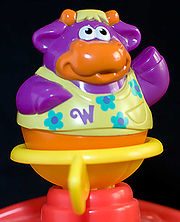
A toy or plaything is an object that is used primarily to provide entertainment. Simple examples include toy blocks, board games, and dolls. Toys are often designed for use by children, although many are designed specifically for adults and pets. Toys can provide utilitarian benefits, including physical exercise, cultural awareness, or academic education. Additionally, utilitarian objects, especially those which are no longer needed for their original purpose, can be used as toys. Examples include children building a fort with empty cereal boxes and tissue paper spools, or a toddler playing with a broken TV remote control. The term "toy" can also be used to refer to utilitarian objects purchased for enjoyment rather than need, or for expensive necessities for which a large fraction of the cost represents its ability to provide enjoyment to the owner, such as luxury cars, high-end motorcycles, gaming computers, and flagship smartphones.

A doll is a model typically of a human or humanoid character, often used as a toy for children. Dolls have also been used in traditional religious rituals throughout the world. Traditional dolls made of materials such as clay and wood are found in the Americas, Asia, Africa and Europe. The earliest documented dolls go back to the ancient civilizations of Egypt, Greece, and Rome. They have been made as crude, rudimentary playthings as well as elaborate art. Modern doll manufacturing has its roots in Germany, from the 15th century. With industrialization and new materials such as porcelain and plastic, dolls were increasingly mass-produced. During the 20th century, dolls became increasingly popular as collectibles.
An action figure is a poseable character model figure made most commonly of plastic, and often based upon characters from a film, comic book, military, video game or television program; fictional or historical. These figures are usually marketed toward boys and adult collectors. The term was coined by Hasbro in 1964 to market G.I. Joe to boys.

A sex doll is an anthropomorphic sex toy in the size and shape of a sexual partner. The sex doll may consist of an entire body, or just a head, pelvis, or other body part intended for sexual stimulation. Sex dolls are made from various materials like silicone, TPE, or rubber to replicate a lifelike feel. These materials are chosen for their durability and realistic texture, enhancing the overall experience for users. The parts sometimes vibrate and may be moveable and interchangeable. Sex dolls exist in many forms, but are usually distinguished from sex robots, which are anthropomorphic creations designed to be able to engage in more complex interactions.

A Daruma doll is a hollow, round, Japanese traditional doll modeled after Bodhidharma, the founder of the Zen tradition of Buddhism. These dolls, though typically red and depicting the Indian monk, Bodhidharma, vary greatly in color and design depending on region and artist. Though considered a toy by some, Daruma has a design that is rich in symbolism and is regarded more as a talisman of good luck to the Japanese. Daruma dolls are seen as a symbol of perseverance and good luck, making them a popular gift of encouragement. The doll has also been commercialized by many Buddhist temples to use alongside the setting of goals.

Matryoshka dolls, also known as stacking dolls, nesting dolls, Russian tea dolls, or Russian dolls, are a set of wooden dolls of decreasing size placed one inside another. The name matryoshka, mainly known as "little matron", is a diminutive form of Matryosha (Матрёша), in turn a diminutive of the Russian female first name Matryona (Матрёна).

A bobblehead, also known by nicknames such as nodder, wobbler, or wacky wobbler, is a type of small collectible figurine. Its head is often oversized compared to its body. Instead of a solid connection, its head is connected to the body by a spring or hook in such a way that a light tap will cause the head to move around, or "bobble", hence the name.
The Mego Corporation is an American toy company that in its original iteration was first founded in 1954. Originally known as a purveyor of dime store toys, in 1971 the company shifted direction and became famous for producing licensed action figures, celebrity dolls, and the Micronauts toy line. For a time in the 1970s, their line of 8-inch-scale action figures with interchangeable bodies became the industry standard.

A toy soldier is a miniature figurine that represents a soldier. The term applies to depictions of uniformed military personnel from all eras, and includes knights, cowboys, American Indians, pirates, samurai, and other subjects that involve combat-related themes. Toy soldiers vary from simple playthings to highly realistic and detailed models. The latter are of more recent development and are sometimes called model figures to distinguish them from traditional toy soldiers. Larger scale toys such as dolls and action figures may come in military uniforms, but they are not generally considered toy soldiers.

Weebles is a range of children's roly-poly toys that was introduced in 1971 by the US toy company Hasbro and currently marketed under their Playskool brand. They are egg-shaped, so tipping one causes a weight located at the bottom-center to be raised. Once released, the Weeble is restored by gravity to an upright position. Weebles have been designed with a variety of shapes, including some designed to look like people or animals.
A balance board is a device used as a circus skill, for recreation, balance training, athletic training, brain development, therapy, musical training and other kinds of personal development.

Okiagari-koboshi or Okiagari-kobōshi is a Japanese traditional doll. The toy is made from papier-mâché and is a roly-poly toy, designed so that its weight causes it to return to an upright position if it is knocked over. Okiagari-kobōshi is considered a good-luck charm and a symbol of perseverance and resilience.

Fisher-Price, Inc. is an American company that produces educational toys for infants, toddlers and preschoolers, headquartered in East Aurora, New York. It was founded in 1930 during the Great Depression by Herman Fisher, Irving Price, Helen Schelle, and Margaret Evans Price.
The Imaginext System is a brand of role-playing, adventure toys designed for kids 3 or older made by Mattel, under the label of Fisher-Price.

An automatic center punch is a hand tool used to produce a dimple in a workpiece. It performs the same function as an ordinary center punch but without the need for a hammer. When pressed against the workpiece, it stores energy in a spring, eventually releasing it as an impulse that drives the punch, producing the dimple. The impulse provided to the point of the punch is quite repeatable, allowing for uniform impressions to be made.

An artificial vagina is a device designed to imitate the vagina as well as sometimes the vulva. To achieve this, it will generally be made of a soft material, lubricated, and occasionally heated.

The Sonny & Cher dolls were a collection of 12-¼ inch high celebrity doll likenesses of pop rock duo Sonny & Cher. The line was released by Mego Corporation in 1976. The release of these fashion dolls coincided with the popularity of The Sonny & Cher Show prime time variety TV show.

The Thanjavur doll is a type of traditional Indian bobblehead or roly-poly toy made of terracotta material. The centre of gravity and total weight of the doll is concentrated at its bottom-most point, generating a dance-like continuous movement with slow oscillations. These toys are traditionally handmade, finished with detailed, painted exteriors. They have been recognized as a Geographical Indication by the Government of India as of 2008-09.

Girls' toys and games are toys and games specifically targeted at girls by the toy industry. They may be traditionally associated either exclusively or primarily with girls by adults and used by girls as an expression of identity. One commentator have argued that the market for girl's toys and games is more challenging than that for boys' toys and games.

















